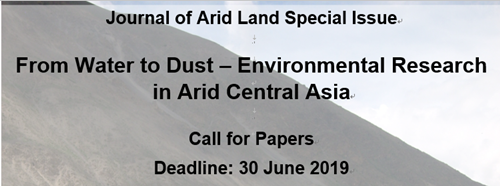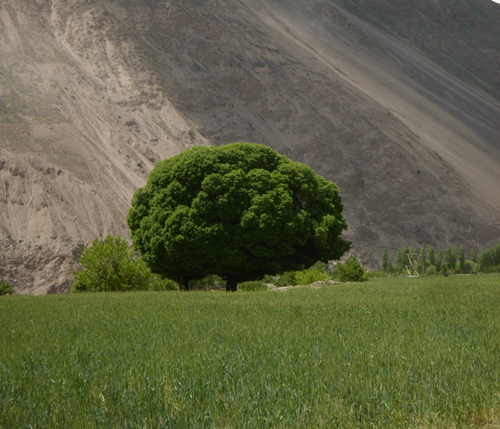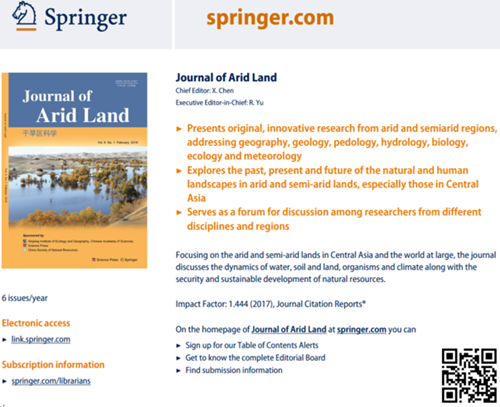JAL- SI Central Asia - Call for Papers
2019-01-03


Table of Contents
1. Context..................................................................................................................2
2. About the Journal of Arid Land .............................................................................2
3. Thematic Scope of the Special Issue ...................................................................3
4. Regional Scope of the Special Issue……………...................................................4
5. Editorial Board for the JAL Special Issue……………….........................................4
6. Call for Papers.......................................................................................................5
1. Context
For many centuries Central Asia has been the crucial link between east and west, one of the main hubs of the Silk Road network and a melting pot of cultures, religions and languages. But this region is equally diverse with regards to its physical features – from the high mountains of the Pamir and Tian Shan, known as the Central Asian water towers, to the arid lowlands of the Aral Sea basin, characterized by intensive irrigation farming. The region’s wealth in various natural resources like ores, oil and gas has only increased its geopolitical importance as the Eurasian heartland. Due to its great complexity and unique set of features, Central Asia has been an interesting study area for researchers from all over the world. For more than 100 years, research in this region has progressed our understanding in many areas, from glaciology to political sciences and from agriculture to soil science. The post-soviet transformation and the impact of climate change have added new challenges, but also new opportunities. Today scientists from many different countries are working together in order to meet these new challenges and to turn those opportunities into reality.
2. About the Journal of Arid Land
The Journal of Arid Land is an international peer-reviewed journal co-sponsored by Xinjiang Institute of Ecology and Geography, the Chinese Academy of Sciences and Science Press. It aims to meet the needs of researchers, students and practitioners in sustainable development and eco-environmental management, focusing on the arid and semi-arid lands in Central Asia and the world at large.
The Journal covers such topics as the dynamics of natural resources (including water, soil and land, organism and climate), the security and sustainable development of natural resources, and the environment and the ecology in arid and semi-arid lands, especially in Central Asia. Coverage also includes interactions between the atmosphere, hydrosphere, biosphere, and lithosphere, and the relationship between these natural processes and human activities. Also discussed are patterns of geography, ecology and environment; ecological improvement and environmental protection; and regional responses and feedback mechanisms to global change. The Journal of Arid Land also presents reviews, brief communications, trends and book reviews of work on these topics.

3. Thematic Scope of the Special Issue
The JAL special issue From Water to Dust – Environmental Research in Arid Central Asia is open to all contributions that deal with current and future challenges and opportunities relevant to Central Asia – from climate change to integrated water resource management, from rural livelihood diversification to combating desertification, from nature protection to transboundary cooperation, from human health issues to green economy, from dust storms to brain drain and from sustainable cities to the 21st century Silk Road.
This special issue aims at collecting papers highlighting a wide range of topics like:
· current problems and challenges of the water resources management and the water-energy-food nexus in Arid Central Asia;
· Natural disasters and impacts of climate change on Arid Central Asia;
· working with and overcoming data scarcity in spatial studies;
· land abandonment, degradation and desertification and their relation to natural and anthropogenic processes;
· reconstructing historical environmental conditions and using such analyses for improving the understanding of complex systems and as a basis for future projections;
· impacts of environmental problems on human health;
· social and economic dimensions of water scarcity, climate change, desertification and other environmental problems in Arid Central Asia;
· present and future socioeconomic development and its relevancy for the Central Asian environments;
· best-practice examples, technical solutions and management recommendations for overcoming (interdisciplinary) environmental issues;
4. Regional Scope of the Special Issue
This JAL special issue defines Central Asia in accordance with the UNESCO definition as the five Central Asian countries of Kazakhstan, Kyrgyzstan, Uzbekistan, Tajikistan, Turkmenistan, as well as parts of Afghanistan, China, India, Iran, Mongolia, and Pakistan.
5. Editorial Board for the JAL Special Issue
For this special issue the journal’s editorial board is complemented by an international team of (guest) editors:
Dr. Michael Groll University of Marburg, Marburg, Germany
michael.groll@staff.uni-marburg.de
Prof. Dr. Bernd Cyffka Catholic University of Eichstaett-Ingolstadt, Eichstaett, Germany
bern.cyffka@ku-eichstaett.de
Dr. Fabian L?w MapTailor Geospatial Consulting, Bonn, Germany
fabian.loew@maptailor.net
Prof. Dr. Philip Micklin Western Michigan University, Kalamazoo, USA
philip.micklin@wmich.edu
Dr. Yang Yu Xinjiang Institute of Ecology and Geography, Chinese Academy of Sciences, Urumqi, China yuyang@ms.xjb.ac.cn
6. Call for Papers
The editorial team invites both original research papers and review papers that fit within the scope outlined in this document. The main focus of the submitted papers should lie on environmental studies in Central Asia, but comparative studies and methodological papers are also welcome as long as they are relevant for the topic of this special issue.
Submission of Full Paper
In order to contribute to this special issue, please carefully read and follow the instructions for authors which you may find online at
http://www.springer.com/cda/content/document/cda_downloaddocument/40333_Guide+for+Authors%28JAL%29.pdf?SGWID=0-0-45-1598729-p174557771
Research papers should not exceed 12 printed pages (including figures and tables) with an abstract of 300 to 500 words.
Review papers should not exceed 15 pages.
Before submitting your paper, you will need to create a user account and then submit all relevant files online at https://mc03.manuscriptcentral.com/xjjal.
Manuscripts can be submitted during the following time frame:
OPENING: 01 January 2019
DEADLINE: 30 June 2019
All submissions will be reviewed according to the standards of the Journal of Arid Land. Authors need to provide the names of two reviewers, complementing the reviewers selected by the journal's editorial board. Revisions of the submissions, if necessary, are expected to be worked on in a timely manner after the review.



